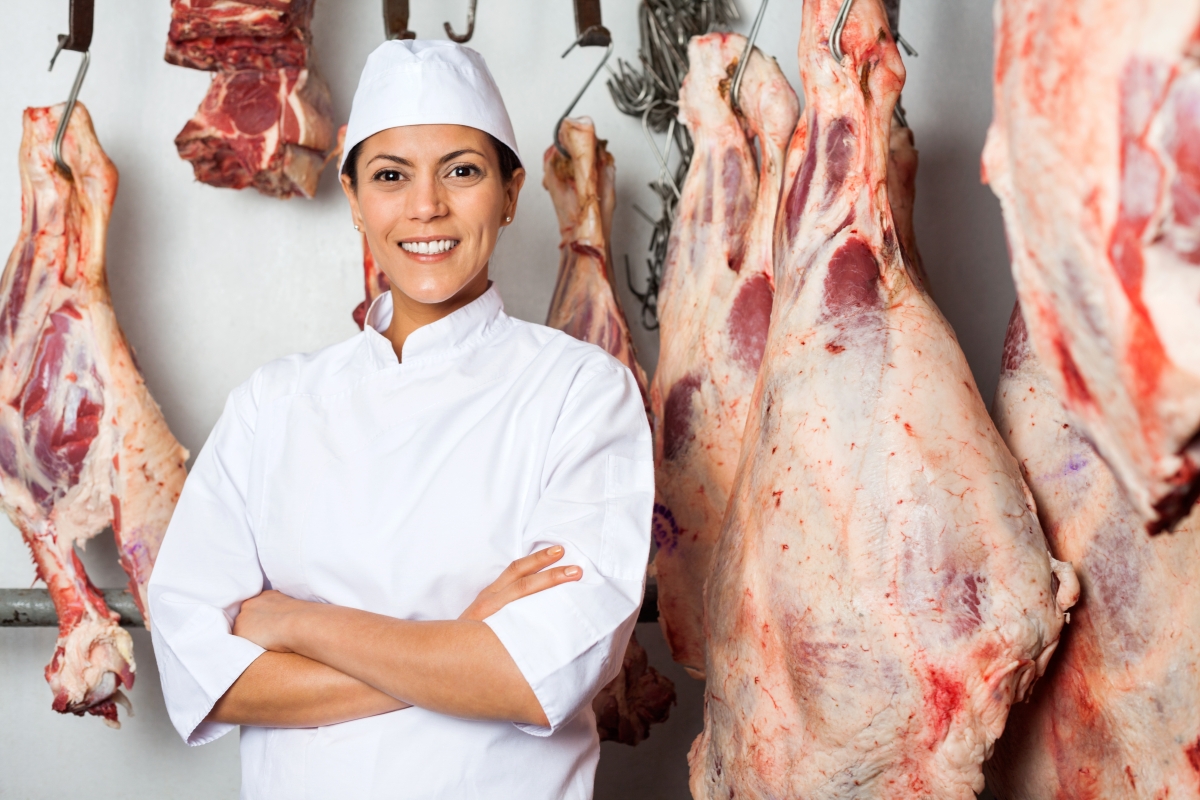Career Overview
Workers in this group:
- Prepare meat and poultry for further processing, for packaging or for marketing
- Work in meat and poultry slaughtering, processing and packing establishments
Job Titles
Duties
Industrial butchers
- Slaughter livestock using stunning devices and knives
- Skin, clean and trim carcasses
- Remove viscera and other inedible parts from carcasses
- Split carcasses into smaller portions for handling
- May slaughter cattle, calves and sheep as set out by religious laws
Industrial meat cutters
- Cut beef, lamb, pork or veal carcasses or sides or quarters of carcasses into primal cuts for further cutting, processing or packaging
- Remove bones from meat
- Cut meat and poultry into specific cuts for institutional, commercial or other wholesale use
Poultry preparers
- Slaughter poultry and remove inedible parts
- Remove feathers and singe and wash poultry to prepare for further processing or packaging
Trimmers
- Remove skin, excess fat, bruises or other blemishes from carcasses or meat portions
Earnings
Earnings is income that workers receive in exchange for their labour. Depending on the type of employment, earnings can be in the form of wages (hourly), salaries (fixed monthly or annual) or self-employed earnings.
Work Environment
# Workers Employed
1,180% Employed Full Time
65%Key aspects of the work in this occupation:
- Work takes place in a regular controlled indoor environment
- Workers may be exposed to infectious bacteria and viruses when handling meat and poultry
- Working with equipment, instruments, machinery or power/hand tools can be a source of injury
- Workers may be exposed to airborne particles such as feathers in the work environment
- The workplace may be noisy enough to cause distraction or hearing loss
- Workers may be exposed to strong or toxic odours
- Work involves contact with water
Career Pathways
Progression to supervisory positions is possible with experience.
Industrial meat cutters may progress to inspecting, testing and grading jobs.
Related Careers
Occupational Interests
It’s important to understand what kinds of occupations align with your interests.
For more about occupational interests visit Skills for the Future Workforce > Characteristics.
Here are the top occupational interest(s) for this career profile:
Education, Training and Skills
- Completion of secondary school may be required
- For industrial meat cutters, completion of a program in industrial meat cutting or Experience as an industrial butcher or trimmer is required
- On-the-job training is provided for industrial butchers, poultry preparers and trimmers
Education programs in B.C.

Skills
Every job calls for a certain set of skills. Knowing those skills is the first step in finding a good career fit.
Here, you will find the 10 most relevant workplace skills. Some are more important to achieving success in a certain career than others. These skills may come naturally to you or you may need to gain them through education, training and experience.
See the list of work-related skills below, ranked in order of importance for this career. Check out the list and see if this career matches your skills—take that first step!
Talking to others to share information effectively.
Giving full attention to what other people are saying, taking time to understand the points being made, asking questions as appropriate, and not interrupting at inappropriate times.
Using logic and reasoning to identify the strengths and weaknesses of alternative solutions, conclusions or approaches to problems.
Being aware of others’ reactions and understanding why they react as they do.
Keeping track of and assessing your performance, other individuals, or organizations to make improvements or take corrective action.
Considering the relative costs and benefits of potential actions to choose the most appropriate one.
Adjusting actions in relation to others' actions.
Managing one’s own time and the time of others.
Watching gauges, dials or other indicators to make sure that a machine is working properly.
Actively looking for ways to help people.
Labour Market Statistics
Discover data, facts and information that have been gathered and analyzed. Learn about the characteristics of the economy and labour market in B.C.
Employment
Find out about employment types and trends by region and industry.
Employment
1,180Employment by Region







| Region | Employment | % Employment of this Occupation |
|---|---|---|
| Cariboo | 10 | 0.8% |
| Kootenay | 10 | 0.8% |
| Mainland/Southwest | 955 | 80.6% |
| North Coast and Nechako | 30 | 2.5% |
| Northeast | 20 | 1.7% |
| Thompson-Okanagan | 95 | 8.0% |
| Vancouver Island/Coast | 60 | 5.1% |
Labour Market Outlook
The B.C. Labour Market Outlook is a 10-year forecast of the expected supply and demand for labour in the province. It’s usually updated every year. The purpose is to provide British Columbians with the knowledge to make informed decisions on careers, skills training, education and hiring.
Forecasted Job Openings (2024-2034)
760Forecasted Job Openings
Forecasted Employment Growth Rate
Composition of Job Openings
Job Openings by Region (2024-2034)







| Region | Job Openings | Avg. Annual Employment Growth |
|---|---|---|
| Cariboo | Not available | Not available |
| Kootenay | Not available | Not available |
| Mainland/Southwest | 620 | 2.0% |
| North Coast and Nechako | 10 | -0.7% |
| Northeast | 30 | 6.1% |
| Thompson-Okanagan | 90 | -0.1% |
| Vancouver Island/Coast | 10 | 0.5% |
Industry Highlights
Learn about the opportunities in B.C.'s major industries, including employment trends, earning potential, locations of work and more.
Forecasted Job Openings by Industry
| Industry | Job Openings (2024-2034) |
|---|---|
| Manufacturing | 640 |
| Retail Trade | 100 |
| Accommodation and Food Services | 10 |
| Agriculture and Fishing | 10 |
Resources
Resource information is currently not available.








